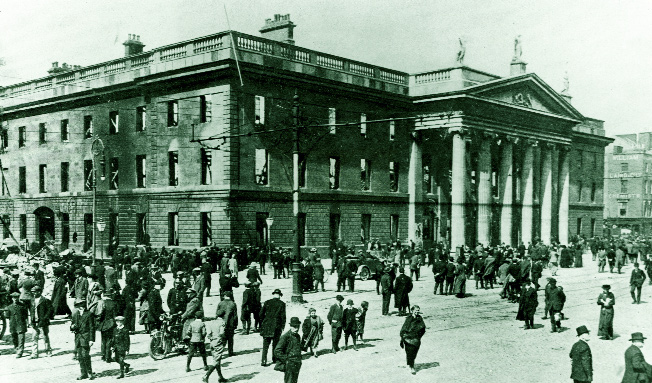‘Why did Jimmie die?’
Published in 20th-century / Contemporary History, Features, Issue 2 (Mar/Apr 2006), Revolutionary Period 1912-23, Volume 14
Life gets back to normal after the Rising outside the ruins of the GPO. (National Museum of Ireland)
In the early days of his dialogue with Sinn Féin, John Hume was fond of posing the question: ‘Why did Jimmie die?’ He knew it was the most difficult question for the Republican movement and its supporters. How could they justify settling for less than their ideal, given the sacrifice of volunteers along the way? I remember a discussion with an SDLP student at the time—a student who has since evolved into a senior political figure—who confidently predicted that Sinn Féin could never really answer that question. When the inevitable compromise came—‘Sunningdale for slow learners’, in Seamus Mallon’s famous phrase—Sinn Féin would be hopelessly exposed before the northern nationalist electorate as having perpetrated mass murder for no rational reason. The British had offered Sunningdale in 1974, and when, in its aftermath, British Prime Minister Harold Wilson explored the policy of withdrawal, he was vetoed by the Irish state, literally terrified by the task of taking on the North. Since then, all deaths accepted by the Provisional movement—and remember, IRA volunteers were five times more likely to kill than be killed—had been for nothing, a mindless bloody pursuit of the unattainable, fuelled by ethnic hatred but little political intelligence. But what has happened? My SDLP student was quite wrong. The compromise was exactly as he had predicted, but since 2001 Sinn Féin has had a clear lead over the SDLP in the political affections of the northern minority. At this moment, Sinn Féin does not even have the pleasure of participation in a partitionist assembly (for which it traded in the Republic) to show for its efforts. This tells us something very important. Even when the outcome of a conflict is demonstrably anticlimactic in terms of its original aspirations, once blood has been spilled in an ethno-national civil war type of conflict, people find it very difficult to declare the whole business a tale told by an idiot, full of sound and fury, signifying nothing. It is a vista too terrible to contemplate. There is, if nothing else, always the story of the ghastliness of ‘the other side’ to keep one warm at night.
![Cartoon from John O'Brien's The vanishing Irish (1954)-‘In 1956 [1916] celebrations were tinged with embarrassment'.](/wp-content/uploads/2013/02/Why-did-Jimmie-die-2.jpg)
Cartoon from John O’Brien’s The vanishing Irish (1954)-‘In 1956 [1916] celebrations were tinged with embarrassment’.
1956 celebrations were tinged with embarrassment
Even a political class less narcissistic than the Dublin one would find it difficult to turn its back on what is undoubtedly the foundational moment in the making of an independent and partitioned Ireland. In 1956 the celebrations were tinged with embarrassment. The revolutionaries had argued that a mix of political sovereignty, nationalist economic policy, radical agrarian policy and compulsory Irish in the schools would produce a Gaelic-speaking nation of 20 million. By 1956 the sustained application of these policies had produced near-collapse and, ironically, higher levels of emigration than in the decades of British rule. Ironically, the one place in Ireland where the population was rising was ‘Ireland unfree’, the ‘black North’.
But in 2006 Ireland has enjoyed a decade and a half of excellent economic growth. There is much to celebrate. Why then not honour the brave men who sacrificed so much for our well-being? In her recent speech in Cork, President MacAleese spoke of an Ireland in 1916 run by reactionary landlord elements in the Kildare Street Club. In fact, these elements had been on the run since the Dublin Castle of Thomas Drummond in the late 1830s had launched its fusillades against them. No doubt, under conservative administrations of the Castle, like those of Robert Peel (1861–5) or Jemmy Lowther (1878–80), they had a bit of a comeback, but Ireland since 1906 had been run by Liberals determined to put an end to this sort of thing and, to be fair to the Tory Dublin Castle of George Wyndham, which immediately preceded it, it had driven the process of land reform. The Rising was not necessary to break any residual influence of Kildare Street over Dublin Castle. A home rule parliament was not even necessary; the Irish Council Bill of 1907 would have been quite enough.
It was precisely because the Kildare Street Club had had its day that the Easter Rising was launched: it was launched not against the landlords of yesteryear but the Irish political leadership of 1916. Redmondism was an uneasy coalition; as Michael Wheatley has recently demonstrated, at a popular level it was characterised by a fairly militant tone: ‘Bellicosity of language, Catholicity, sense of victimhood, glorification of struggle, identification of enemies and antipathy to England . . . suffused provincial nationalist orthodoxy’. But at the élite level, Redmond and those closer to him inhabited a different world: more conciliatory, emotionally conservative and decidedly less Anglophobic. Redmond himself crashed through the glass ceiling for Irish Catholic nationalists when he was offered, and turned down, a place in the British cabinet in 1915. They were impressed by the progress of reform, reaching down even to the agricultural labourer and providing pensions from the British treasury. The final debt owed to history was the establishment of a Dublin parliament; once paid, Dublin could cooperate on equal terms with London, Irish politicians could sit in British cabinets, and the way was opening to win over the Unionists, north and south, by a course of constructive moderation. In the meantime, the effects of partition for northern Catholics would be reduced by a system of direct rule with a green tinge. This was the vision that the Easter Rising destroyed: destroyed, at least in part, on the basis that the insurrectionaries had a better answer to the looming problem of partition. The parliamentary nationalists insisted that they had not—and subsequent history bears out their claim.
To make the case for a rising, the insurrectionaries had to employ a desperately exaggerated language. The ‘secular’ Workers’ Republic declared: ‘Now or never . . . are you going to oblige John Bull, the butcher of your priests and people, by remaining quiet till he is in position to finish you off?’ Arthur Griffith’s Nationality insisted that Ireland was the most heavily taxed country in the history of nations since the fall of the Roman empire, though he did, at least, warn—as Patrick Maume has recently pointed out—that Irish workers should expect a short-term fall in their material standards as a result of independence; yet Connolly dismissed critics of Griffith as ‘tosspots and work-shy’.
The ghost of the Catholic Bulletin
The 1916 men played an undeniable role in determining the style of Irish self-government, which was virtually achieved, but, as Garret FitzGerald has pointed out, the actual attainment of a European route to prosperity in the 1990s has had little to do with the subjective worldview or intentions of the 1916 men. President McAleese is less skilled in handling this paradox. She projects a politically correct ideal—an egalitarian opposition to élitism—onto the insurrectionaries. They are remoulded simply as radical democrats; if they were Catholics, why, that simply gave them access to a wider internationalist culture than the British Empire.

Gerry Adams and John Hume in 1993-‘In the early days of his dialogue with Sinn Féin, John Hume was fond of posing the question: “Why did Jimmie die?‒ (An Phoblacht)
Just as the ghost of Ultach and his Capuchin Annual article ‘Orange Terror’ of 1943 lies behind the President’s recent depiction of Ulster unionism as Nazism, so the ghost of the Catholic Bulletin and Father Timothy Corcoran lies behind these remarks, all the more vapid because few today really want this world back—with its prohibitions on contraception, ban on dancehalls and heavy-duty censorship.
The insurrectionaries of 1916 knew that many mainstream Irish nationalists would initially disapprove of their actions. Hence they had a tactical need to stress aspects of their own make-up and mentality that linked them to the broad mass of the people: it made it harder, in the end impossible, for the bulk of Irish people to reject them. This is why Pearse was so relieved when the Marxist Connolly made his peace with the Catholic Church. This is why Connolly took the remarkable step of asking his Protestant wife to convert to Catholicism. When Eamonn Ceannt died under a hail of bullets from a firing squad, clutching a blood-spattered crucifix, he was forging a bond with the broad populace, but the intensity and popularity of the emotions aroused at the same time serve to divide and entrench partition in the hearts and minds of those who live on the island.
For all the recent fashion for ‘counter-factual’ history, it is little more than an amusing educational parlour game. It is possible to argue rationally that a Redmondite strategy could have delivered dominion status without loss of life in Ireland and without the political and economic costs of the 1916 project. But this is not the point. The real task of historical writing is to analyse the meaning of what actually happened: this includes a proper balance sheet of the costs of a political project.
The truth is that modern Ireland today has a complex, distanced relationship to 1916. It does not represent the simple fulfilment of that dream. The economic and social policies of classical Irish republicanism were tried to the point of destruction up to the mid-1950s; then Lemass initiated the revolution in economic strategy, which improved the fortunes of the state. But this was done at the cost of transforming Ireland’s relationship with its own past. Desmond Fennell was quite right to insist that post-Lemass Irish government justifies itself by reference to material–economic achievement rather than the broader political and ideological project as defined by the founding fathers. The uneasy sense that this is so produces a compensating reaction as the state nervously moves to celebrate 1916 in an inevitably rhetorical overblown style. But we are now in a place defined only very partially by the men of 1916. Let us take a simple example: Arthur Griffith’s Sinn Féin denied that Professor Tyndall, the great Carlow-born scientist, could be considered Irish because he was a unionist; today’s Irish schoolchildren are taught that Tyndall is a great architect of modern Irish science. The Good Friday Agreement’s articulation of the consent principle on the North is obviously more Redmondite than classic Irish republican—why not admit it? Then we might be able finally to close the door on that cult of the gun, which, as P. S. O’Hegarty pointed out so clearly after the Civil War, disfigured modern Irish democratic life.
Ten years after the Rising, Stephen Gwynn (formerly Nationalist MP for Galway) revisited the events of Easter 1916. He argued that ten years had been added to the waiting period for Irish political unity and that Ireland would wait forever if it remained chained to the ideal of 1916. Ninety years on, and with no end to partition in sight, why is it so difficult to concede that Stephen Gwynn clearly had a point?
Paul Bew is Professor of Politics at Queen’s University, Belfast.
Further reading:
P. Bew, ‘Moderate Nationalism and the Irish revolution 1916–23’, Historical Journal 42 (3) (1999).
P. Maume, ‘Lily Connolly’s conversion: new light on James Connolly’s last days’, History Ireland 2 (3) (Autumn 1994).
P. Maume, The long gestation (Dublin, 1999).
M. Wheatley, Nationalism and the Irish Party: Provincial Ireland 1910–16 (Oxford, 2005).
















